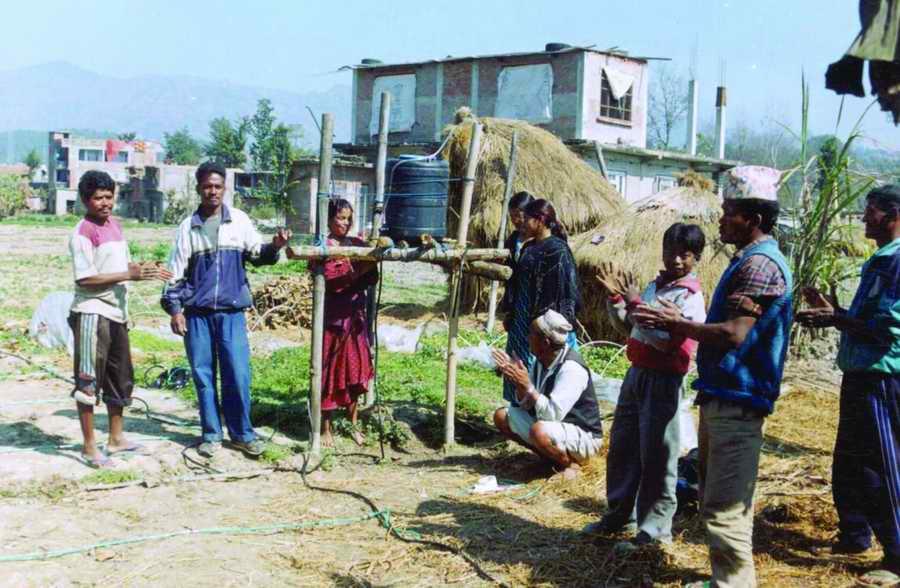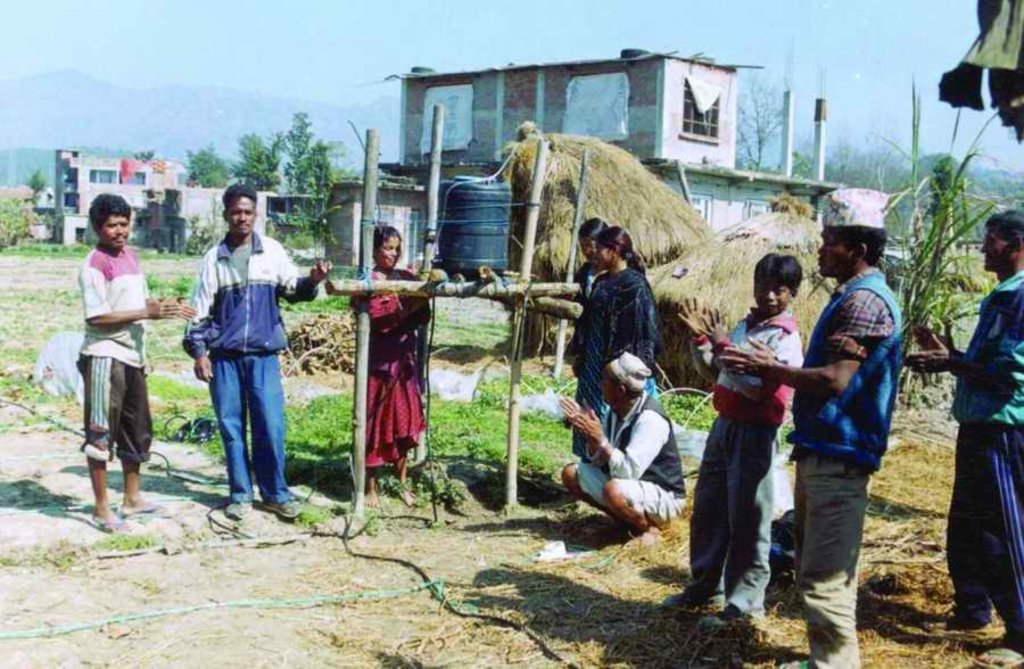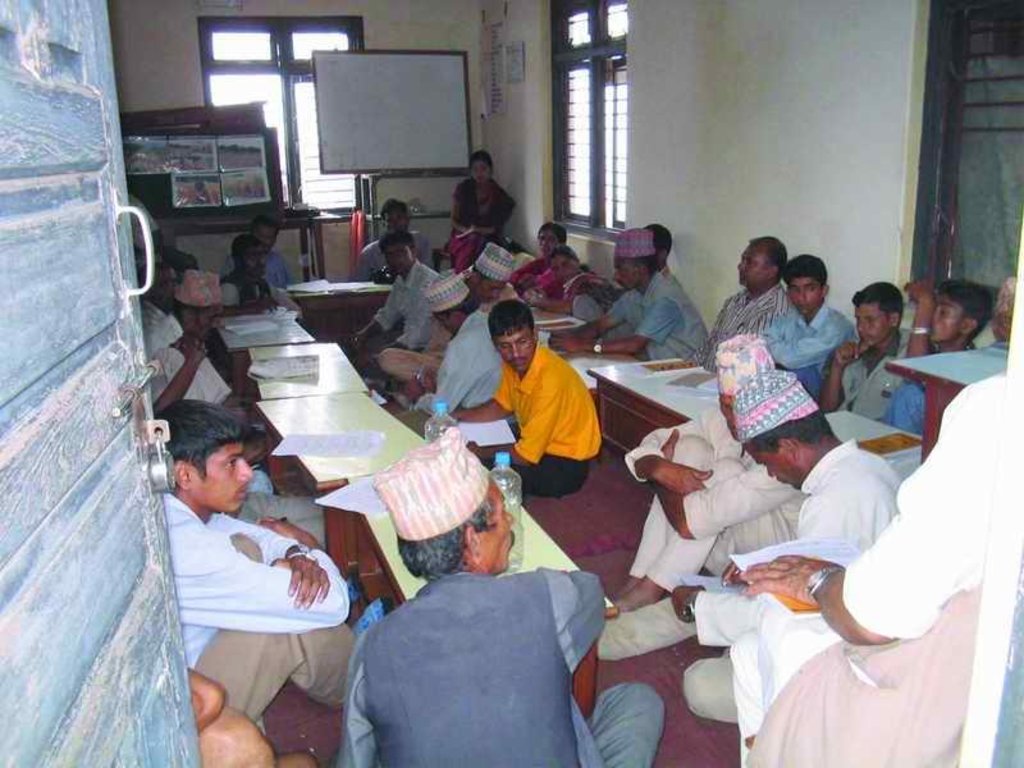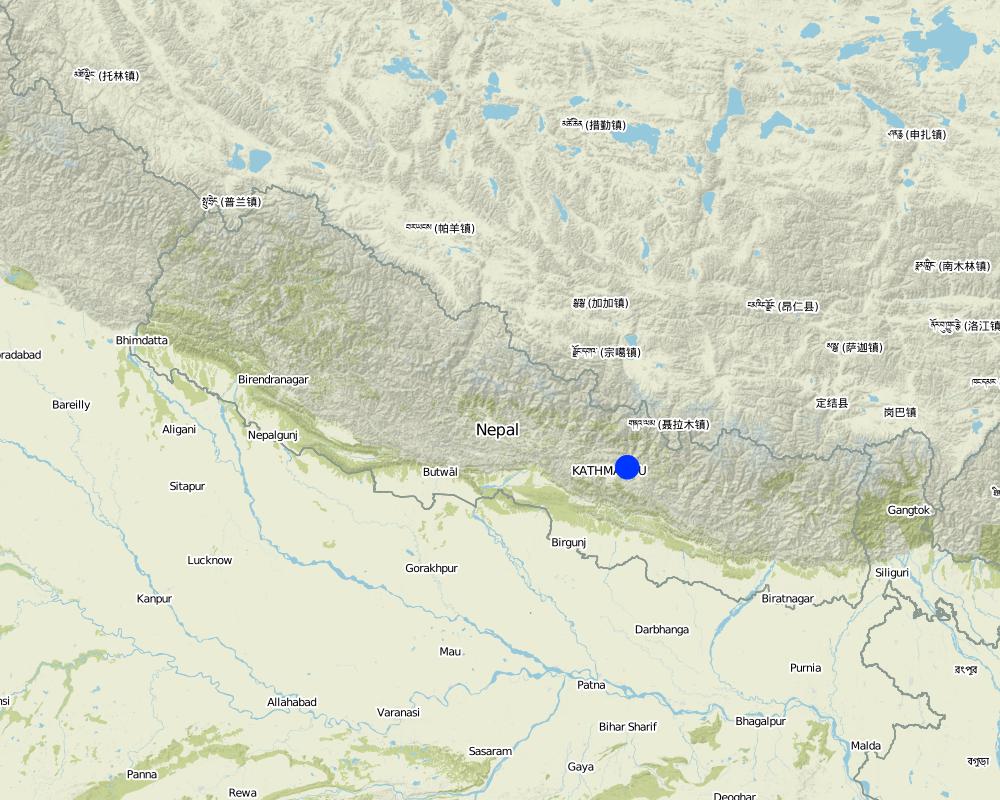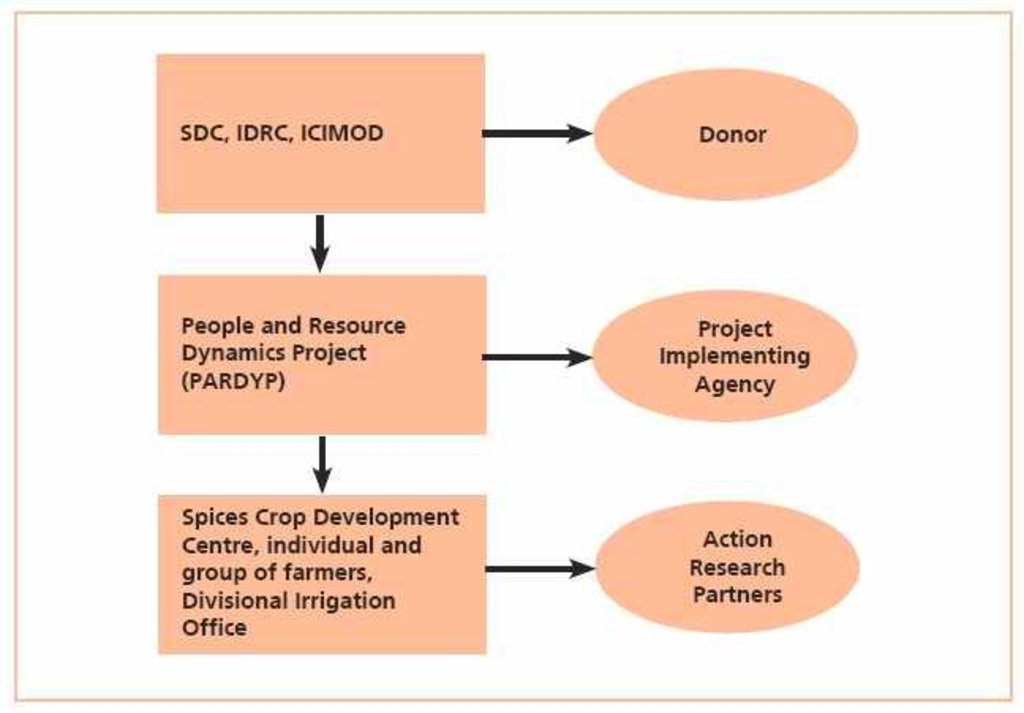Participatory action research on drip irrigation [ເນໂປ]
- ການສ້າງ:
- ປັບປູງ:
- ຜູ້ສັງລວມຂໍ້ມູນ: Madhav Dhakal
- ບັນນາທິການ: –
- ຜູ້ທົບທວນຄືນ: Laura Ebneter
approaches_2350 - ເນໂປ
ເບິ່ງພາກສ່ວນ
ຂະຫຍາຍທັງໝົດ ຍຸບທັງໝົດ1. ຂໍ້ມູນທົ່ວໄປ
1.2 ລາຍລະອຽດ ການຕິດຕໍ່ ຂອງບຸກຄົນທີ່ຊັບພະຍາກອນ ແລະ ສະຖາບັນ ການມີສ່ວນຮ່ວມ ໃນການປະເມີນຜົນ ແລະ ເອກະສານ ຂອງວິທີທາງ
ຜູ້ຊ່ຽວຊານ ດ້ານການຄຸ້ມຄອງ ທີ່ດິນແບບຍືນຍົງ:
ຊື່ຂອງ ສະຖາບັນການຈັດຕັ້ງ ທີ່ອໍານວຍຄວາມສະດວກ ໃນການສ້າງເອກກະສານ ຫຼື ປະເມີນແນວທາງ (ຖ້າກ່ຽວຂ້ອງ)
CDE Centre for Development and Environment (CDE Centre for Development and Environment) - ສະວິດເຊີແລນຊື່ຂອງ ສະຖາບັນການຈັດຕັ້ງ ທີ່ອໍານວຍຄວາມສະດວກ ໃນການສ້າງເອກກະສານ ຫຼື ປະເມີນແນວທາງ (ຖ້າກ່ຽວຂ້ອງ)
ICIMOD International Centre for Integrated Mountain Development (ICIMOD) - ເນໂປ1.3 ເງື່ອນໄຂ ຂອງການນໍາໃຊ້ເອກກະສານຂໍ້ມູນ ຂອງ WOCAT
ຜູ້ສັງລວມ ແລະ ບັນດາຜູ້ຕອບແບບສອບຖາມ ຍອມຮັບໃນເງື່ອນໄຂ ການນໍາໃຊ້ຂໍ້ມູນເອກະສານ ທີ່ສ້າງຂື້ນ ໂດຍຜ່ານ ອົງການ WOCAT:
ແມ່ນ
1.4 ເອກະສານອ້າງອີງ (ຫຼາຍ) ກັບແບບສອບຖາມ (ຫຼາຍ) ເຕັກໂນໂລຢີ ຂອງດ້ານການຄຸ້ມຄອງ ດິນແບບຍືນຍົງ
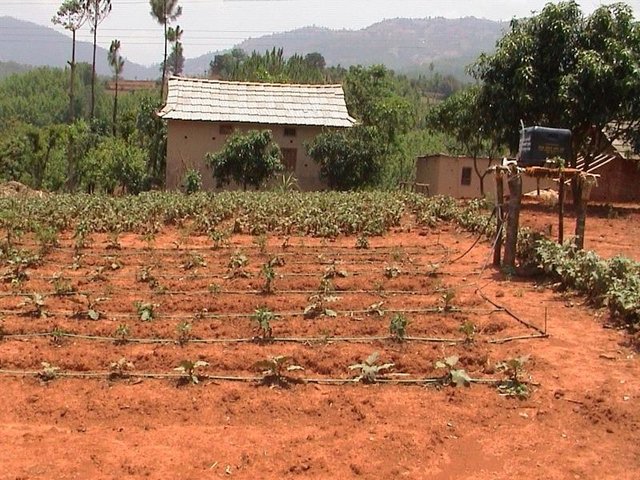
Low cost drip irrigation [ເນໂປ]
An irrigation system which allows the slow and precise delivery of water to crops
- ຜູ້ສັງລວມຂໍ້ມູນ: Madhav Dhakal
2. ພັນລະນາ ແນວທາງການຄຸ້ມຄອງນໍາໃຊ້ດິນແບບຍືນຍົງ
2.1 ການອະທິບາຍ ໂດຍຫຍໍ້ ຂອງວິທີທາງ
Conducting participatory action research with farmers and line agencies for demonstrating, disseminating and scaling up drip irrigation.
2.2 ການອະທິບາຍ ລາຍລະອຽດ ຂອງວິທີທາງ
ການອະທິບາຍ ລາຍລະອຽດ ຂອງວິທີທາງ:
Most farming in the uplands of Nepal's midhills is rainfed with many fi elds remaining fallow during the dry season due to lack of irrigation water. The People and Resource Dynamics Project (PARDYP) water demand and supply survey identified scarcity of irrigation water as a major issue in Nepal's midhills. To assess the potential of drip irrigation to address this problem, the University of British Columbia (UBC) in 2000/2001, in collaboration with PARDYP, tested a low cost irrigation drip set and a more costly set in the Jhikhu Khola watershed; and PARDYP and Tribhuvan University's Institute of Engineering (Nepal) tested the low cost set with farmers at another site at Kubinde village, Kavre.
PARDYP started research on drip irrigation at an agricultural research station (the Spices Crop Development Centre at Tamaghat, Kabhrepalanchok) and brought different stakeholders, principally farmers, to the station to learn. After seeing the trials some farmers, especially those living near the research station, started testing drip irrigation on their farms. From 2001 to 2004, PARDYP subsidised 50% of the cost of the drip sets to most adopting farmers. PARDYP organised several farm visits for stakeholders to the research station and farmers’ fi elds. The number of interested farmers increased and many started testing and demonstrating the technology on their farms. PARDYP provided technical support during installation, advice about water application, and trouble shooting training to user farmers. Soon, many farmers started using drip irrigation with little or no technical support from PARDYP. Some collected quantitative and qualitative information on the performance of their systems. Results and experiences were shared regularly after cropping seasons through interaction meetings. Users’ experiences convinced many others to adopt the technology.
Interaction meetings were organised to communicate farmers’ feedback to the organisation and businesses involved in making the drip sets. Farmers from the watershed were taken to the drip set manufacturers to establish a direct link between them and to allow the project to phase out its support.
This approach emphasised on-station to on-farm research and demonstration to facilitate ongoing monitoring and evaluation of the performance of locally made drip sets.
2.3 ຮູບພາບຂອງແນວທາງ
2.5 ປະເທດ / ເຂດ / ສະຖານທີ່ບ່ອນທີ່ແນວທາງໄດ້ຖືກນໍາໃຊ້
ປະເທດ:
ເນໂປ
ຂໍ້ມູນເພີ່ມເຕີມຂອງສະຖານທີ່:
Kavrepalanchowk/ Jhikhu Khola watershed
Map
×2.6 ວັນທີເລີ່ມຕົ້ນ ແລະ ສິ້ນສຸດ ການຈັດຕັ້ງປະຕີບັດ ວິທີທາງ
ປີທີ່ສີ້ນສູດ (ຖ້າຢຸດບໍ່ໄດ້ນໍາໃຊ້ ວິທີທາງ):
2005
2.7 ປະເພດຂອງແນວທາງ
- ພາຍໃຕ້ໂຄງການ / ແຜນງານ
2.8 ເປົ້າໝາຍ / ຈຸດປະສົງຫຼັກ ຂອງການຈັດຕັ້ງປະຕິບັດ ວິທີທາງ
The Approach focused mainly on SLM with other activities (income generating activities, vegetable farming with micro irrigation system)
To test, demonstrate, and evaluate drip irrigation systems under local conditions with multiple stakeholders. To share results and experiences with communities to scale up the technology
The SLM Approach addressed the following problems: - Lack of systematic on-farm research on drip irrigation. - Weak institutional collaboration for developing, disseminating and scaling up drip technology. - Inadequate water available for agriculture alongside strong seasonality and poor irrigation facilities
2.9 ເງື່ອນໄຂອໍານວຍ ຫຼື ຂັດຂວາງການປະຕິບັດຂອງເຕັກໂນໂລຢີ / ເຕັກໂນໂລຢີການນໍາໃຊ້ຕາມແນວທາງ
ມີຄວາມສາມາດ / ເຂັ້າເຖິງຊັບພະຍາກອນດ້ານການເງິນ ແລະ ການບໍລິການ
- ເຊື່ອງຊ້ອນ
Insufficient government incentives
Treatment through the SLM Approach: A Cost-effective technology and implementing approach
ການກໍ່ຕັ້ງສະຖາບັນ
- ເຊື່ອງຊ້ອນ
Weak institutional collaboration among line agencies
Treatment through the SLM Approach: Participatory action research with several institutions - universities, local research centres, and farmers
ກ່ຽວກັບກົດໝາຍ (ສິດນໍາໃຊ້ດິນ, ສິດນໍາໃຊ້ນໍ້າ)
- ອໍານວຍ
The existing land ownership, land use rights / water rights greatly helped the approach implementation: Because of private land owners there were no conflicts on land to implement the technology and for it's dissemination. and scaling up.
ຄວາມຮູ້ກ່ຽວກັບການຄຸ້ມຄອງ ທີ່ດິນແບບຍືນຍົງ, ການເຂົ້າເຖິງການສະໜັບສະໜູນ ທາງດ້ານວິຊາການ
- ເຊື່ອງຊ້ອນ
Promotion of micro irrigation was not a priority of line agencies in the study area
Treatment through the SLM Approach: Technology implemented with multiple stakeholders' participation
ອື່ນໆ
- ເຊື່ອງຊ້ອນ
Lack of awareness on potential water-saving options
Treatment through the SLM Approach: Community-based training, discussions and field visits
3. ການມີສ່ວນຮ່ວມ ແລະ ບົດບາດຂອງພາກສ່ວນທີ່ກ່ຽວຂ້ອງທີ່ໄດ້ມີສ່ວນຮ່ວມ
3.1 ຜູ້ມີສ່ວນຮ່ວມ ໃນວິທີທາງ ແລະ ພາລະບົດບາດ ຂອງເຂົາເຈົ້າ
- ຜູ້ນໍາໃຊ້ດິນໃນທ້ອງຖິ່ນ / ຊຸມຊົນທ້ອງຖິ່ນ
On farm research and demonstration
men and women worked equally
- ອົງການຈັດຕັ້ງ ພາຍໃນຊຸມຊົນ
existing groups of land users; community forest user group and terrace improvement committee
- ຜູ້ຊ່ຽວຊານ ການນຄຸ້ມຄອງ ທີ່ດິນແບບຍືນຍົງ / ທີ່ປຶກສາດ້ານກະສິກໍາ
Field technicians
- ອົງການຈັດຕັ້ງ ທີ່ບໍ່ຂື້ນກັບລັດຖະບານ
On station research
- ພະນັກງານຂັ້ນສູນກາງ (ຜູ້ວາງແຜນ, ຜູ້ສ້າງນະໂຍບາຍ)
On station research
- ອົງການຈັດຕັ້ງ ສາກົນ
On station research
3.2 ການມີສ່ວນຮ່ວມຂອງຜູ້ນໍາໃຊ້ທີ່ດິນໃນທ້ອງຖິ່ນ / ຊຸມຊົນທ້ອງຖິ່ນໃນໄລຍະທີ່ແຕກຕ່າງກັນຂອງແນວທາງ
| ການລວບລວມ ເອົາຜູ້ນໍາໃຊ້ດິນ ໃນທ້ອງຖິ່ນ / ຊຸມຊົນທ້ອງຖິ່ນ | ໃຫ້ລະບຸ ຜູ້ໃດທີ່ມີສ່ວນຮ່ວມ ໃນແຕ່ລະກິດຈະກໍາ? | |
|---|---|---|
| ການເລີ່ມຕົ້ນ / ແຮງຈູງໃຈ | ການຮ່ວມມື | A water demand and supply survey identified problem of lack of water in the dry season for irrigating crops. The concept of drip irrigation was shared at public meetings and a demonstration plot established at a local agricultural research centre. Several farmer visits organised to the research cent |
| ການວາງແຜນ | ການຮ່ວມມື | Public meetings; farmers showed interest in drip irrigation. The project supported them by transporting drip sets to the nearest roadhead and subsidising the purchase costs |
| ການປະຕິບັດ | ການນໍາໃໍຊ້ເອງ | Farmers implemented the technology and the project provided technical support |
| ຕິດຕາມກວດກາ / ການປະເມີນຜົນ | ການຮ່ວມມື | Mainly: measurements/observations, public meetings; partly: reporting; Farmers monitored the technology with project support. Evaluation was usually done at meetings and exchange visits. |
| Research | ການນໍາໃໍຊ້ເອງ | On-farm; The technology was tested at the local research centre during the first few years followed by on-farm research with farmers. Farmers collected and analysed quantitative and qualitative information themselves. |
3.3 ແຜນວາດ (ຖ້າມີ)
ການອະທິບາຍ:
PARDYP project donors and implementing partners: SDC (Swiss Agency for Development and Cooperation); IDRC (International Development Research Centre); ICIMOD
3.4 ການຕັດສິນໃຈກ່ຽວກັບການຄັດເລືອກເຕັກໂນໂລຢີຂອງການຄຸ້ມຄອງທີ່ດິນແບບຍືນຍົງ / ເຕັກໂນໂລຢີ
ລະບຸ ຄົນທີ່ຕັດສິນໃຈ ກ່ຽວກັບການຄັດເລືອກຂອງ ເຕັກໂນໂລຢີ / ເຕັກໂນໂລຢີ ຈະໄດ້ຮັບການປະຕິບັດ:
- ຜູ້ຊ່ຽວຊານ ຫຼັກດ້ານການຄຸ້ມຄອງ ທີ່ດິນແບບຍືນຍົງ, ມີການຕິດຕາມປຶກສາຫາລືກັບຜູ້ນໍາໃຊ້ທີ່ດິນ
ອະທິບາຍ:
The project tested drip irrigation as a promising water-efficient technology.
Decisions on the method of implementing the SLM Technology were made by mainly by SLM specialists with consultation of land users. It was tested first in the research station to build confidence of the project staff and surrounding villagers, and was then taken to interested farmers' fields.
4. ການສະໜັບສະໜູນທາງດ້ານວິຊາການ, ການສ້າງຄວາມສາມາດ, ແລະ ການຈັດການຄວາມຮູ້.
4.1 ການສ້າງຄວາມສາມາດ / ການຝຶກອົບຮົມ
ຜູ້ນໍາໃຊ້ທີ່ດິນ ຫຼື ພາກສ່ວນກ່ຽວຂ້ອງອື່ນໆ ໄດ້ຮັບການຝຶກອົບຮົມບໍ່?
ແມ່ນ
ໃຫ້ລະບຸ ຜູ້ໃດທີ່ໄດ້ຮັບການຝຶກອົບຮົມ:
- ຜູ້ນໍາໃຊ້ດິນ
- extensionists/trainers
ຮູບແບບຂອງການຝຶກອົບຮົມ:
- ຕົວຕໍ່ຕົວ
- ເນື້ອທີ່ສວນທົດລອງ
- ກອງປະຊຸມ
ໃນຫົວຂໍ້:
Training programmes were organised on how to install and maintain the drip systems. Likewise farmers were trained on record keeping for water application, production, and cost-benefit analysis.
4.2 ການບໍລິການໃຫ້ຄໍາປຶກສາ
ເຮັດຜູ້ໃຊ້ທີ່ດິນມີການເຂົ້າເຖິງການບໍລິການໃຫ້ຄໍາປຶກສາ?
ແມ່ນ
ອະທິບາຍ / ຄວາມຄິດເຫັນ:
Name of method used for advisory service: Farmer to farmer dissemination; Key elements: Interactive meeting, on-station and on-farm visits, workshops; 1) Mainly: projects own extension structure and agents, Partly: non-governmental agency; Extension staff: specifically hired project employees 2) Target groups for extension: land users, technicians/SLM specialists; Activities: interactive meeting, farm visits , workshops
Advisory service is quite adequate to ensure the continuation of land conservation activities; Government , NGOs and CBOs still continuing the activities.
4.3 ສະຖາບັນການສ້າງຄວາມເຂັ້ມແຂງ (ການພັດທະນາອົງການຈັດຕັ້ງ)
ສະຖາບັນ ໄດ້ຮັບການສ້າງຕັ້ງຂື້ນ ຫຼື ໄດ້ຮັບການສ້າງຄວາມເຂັ້ມແຂງ ໂດຍການຈັດຕັ້ງປະຕິບັດ ວິທີທາງບໍ່?
- ມີ, ຫຼາຍ
ລະບຸ ທາງສະຖາບັນ ໄດ້ສ້າງຄວາມເຂັ້ມແຂງ ໃນລະດັບໃດ (ຫຼາຍ):
- ທ້ອງຖິ່ນ
ລະບຸ ປະເພດ ຂອງສະໜັບສະໜູນ:
- ການສ້າງຄວາມອາດສາມາດ / ການຝຶກອົບຮົມ
ໃຫ້ລາຍລະອຽດເພີ່ມເຕີມ:
On-site training during drip installation provided to a local NGO (Ranipani Gram Sewa Kendra) with vegetable seedling support.
4.4 ຕິດຕາມກວດກາ ແລະ ປະເມີນຜົນ
ການຈັດຕັ້ງປະຕິບັດ ວິທີທາງ ໄດ້ມີການປະເມີນຜົນ ແລະ ຕິດຕາມບໍ?
ແມ່ນ
ຄວາມຄິດເຫັນ:
bio-physical aspects were ad hoc monitored through observations; indicators: land use change, crop rotation, soil surveys
technical aspects were regular monitored through measurements; indicators: water requirements
socio-cultural aspects were ad hoc monitored through observations; indicators: socioeconomic surveys
economic / production aspects were ad hoc monitored through measurements; indicators: cost-benefit production
area treated aspects were regular monitored through measurements; indicators: area under drip irrigation
land users involved aspects were regular monitored through observations; indicators: number of drip users
There were few changes in the Approach as a result of monitoring and evaluation: The subsidy system was withdrawn and work with groups rather than single households was started. In addition, interaction programmes were organised at different locations in the watershed.
There were no changes in the Technology as a result of monitoring and evaluation.
4.5 ການຄົ້ນຄວ້າ
ນີ້້ແມ່ນສ່ວນໜຶ່ງ ການຄົ້ນຄວ້າ ຂອງວິທີທາງບໍ່?
ແມ່ນ
ໃຫ້ຂໍ້ມູນ ເພີ່ມເຕີມ ແລະ ກໍານົດ ຜູ້ໃດເຮັດການຄົ້ນຄວ້າ:
Action research was carried out to compare the water requirements, the cost-benefit, and the advantages and disadvantages of traditional and drip irrigation.
Research was carried out both on station and on-farm
5. ການສະໜັບສະໜູນທາງດ້ານການເງິນ ແລະ ອຸປະກອນຈາກພາຍນອກ
5.1 ງົບປະມານປະຈໍາປີ ສໍາລັບວິທີທາງ ຂອງການຄຸ້ມຄອງ ທີ່ດິນແບບຍືນຍົງ
ຖ້າຫາກບໍ່ຮູ້ຈັດງົບປະມານທີ່ແນ່ນອນ ແມ່ນໃຫ້ປະມານເອົາ:
- 2,000-10,000
ຄໍາເຫັນ (ຕົວຢ່າງ: ແຫຼ່ງຂໍ້ມູນຫຼັກ ຂອງການສະໜອງທຶນ / ຜູ້ໃຫ້ທຶນທີ່ສໍາຄັນ):
Approach costs were met by the following donors: international non-government (SDC, IDRC, ICIMOD): 50.0%; local community / land user(s) (labour): 50.0%
5.2 ການສະໜັບສະໜູນ ທາງດ້ານການເງິນ / ອຸປະກອນ ສະໜອງໃຫ້ແກ່ຜູ້ນໍາທີ່ດິນ
ຜູ້ນໍາໃຊ້ດິນ ໄດ້ຮັບການສະໜັບສະໜູນ ທາງດ້ານ ການເງິນ / ອຸປະກອນ ໃນການຈັດຕັ້ງປະຕິບັດ ເຕັກໂນໂລຢີບໍ?
ແມ່ນ
5.3 ເງິນສົມທົບສໍາລັບການນໍາໃຊ້ສະເພາະປັດໃຈຂາເຂົ້າໃນການຜະລີດກະສິກໍາ (ລວມທັງແຮງງານ)
- ອຸປະກອນ
| ໃຫ້ລະບຸໄດ້ຮັບການສະໜັບສະໜູນປັດໃຈຂາເຂົ້າຫຍັງແດ່ | ທີ່ຂອບເຂດ | ລະບຸ ການອຸດໜູນ |
|---|---|---|
| ເຄື່ອງກົນຈັກ | ||
ຖ້າແຮງງານ ຂອງຜູ້ນໍາໃຊ້ດິນ ໄດ້ຮັບການສະໜັບສະໜູນ ປັດໃຈຂາເຂົ້າ, ແມ່ນບໍ່:
- ການອາສາ
ຄວາມຄິດເຫັນ:
Fifty percent subsidy on drip was provided by the project during initial stages (first two years) to a limited farmers.
5.4 ສິນເຊື່ອ
ໄດ້ປ່ອຍສິນເຊື່ອ ສະໜອງໃຫ້ພາຍໃຕ້ ວິທີການສໍາລັບກິດຈະກໍາ ການຄຸ້ມຄອງ ທີ່ດິນແບບຍືນນຍົງບໍ່?
ບໍ່ແມ່ນ
6. ວິເຄາະຜົນກະທົບ ແລະ ສັງລວມບັນຫາ
6.1 ຜົນກະທົບຂອງແນວທາງ
ການຈັດຕັ້ງປະຕິບັດ ວິທີທາງ ສາມາດຊ່ວຍຜູ້ນໍາໃຊ້ທີ່ດິນ ໃນການຈັດຕັ້ງປະຕິບັດ ແລະ ບໍາລຸງຮັກສາ ເຕັກໂນໂລຢີ ການຄຸ້ມຄອງ ທີ່ດິນແບບຍືນຍົງໄດ້ບໍ?
- ບໍ່
- ມີ, ໜ້ອຍໜຶ່ງ
- ມີ, ພໍສົມຄວນ
- ມີ, ຫຼາຍ
Land users started cropping land that was previously left fallow in the dry season and increased the area under cash crops - especially vegetables. Drip irrigation used only 60% of water compared to bucket irrigation.
Na Na
Did other land users / projects adopt the Approach?
- ບໍ່
- ມີ, ໜ້ອຍໜຶ່ງ
- ມີ, ພໍສົມຄວນ
- ມີ, ຫຼາຍ
A few institutions and district level line agencies like Ranipani Gram Sewa Kendra, a local NGO, and the Divisional Irrigation Office Kabhrepalanchok started organising interactive meetings to discuss drip irrigation.
6.2 ແຮງຈູງໃຈຫຼັກຂອງຜູ້ນໍາໃຊ້ທີ່ດິນໃນການປະຕິບັດການຄຸ້ມຄອງທີ່ດິນແບບຍືນຍົງ
- ການຜະລິດເພີ່ມຂຶ້ນ
increased vegetable production
- ການຫຼຸດຜ່ອນພາລະວຽກ
less time required for irrgation, fertigation
6.3 ຄວາມຍືນຍົງຂອງກິດຈະກໍາວິທີທາງ
ຜູ້ນໍາໃຊ້ ທີ່ດິນ ສາມາດສືບຕໍ່ ການຈັດຕັ້ງປະຕິບັດ ຜ່ານວິທີທາງໄດ້ບໍ່ (ໂດຍປາດສະຈາກ ການຊ່ວຍເຫຼືອ ຈາກພາກສ່ວນພາຍນອກ)?
- ແມ່ນ
ຖ້າ ໄດ້, ອະທິບາຍເຫດຜົນ:
Most of the land users continue to use drip irrigation and are maintaining the sets. A few farmers, including women, abandoned drip after using it for some time. The women who abandoned it said they did so because of 'lack of technical knowledge', 'not enough labour' and 'too far to get water'
6.4 ຈຸດແຂງ / ຂໍ້ດີ ຂອງວິທີທາງ
| ຈຸດແຂງ / ຂໍ້ດີ / ໂອກາດໃນການນໍາໃຊ້ທີ່ດິນ |
|---|
| Regular interaction meetings provided land users with a platform to share ideas and for non-adopters to learn about drip from users. (How to sustain/ enhance this strength: Continue such meetings and involve more potential adopters) |
| Farmer-to-farmer visits were helpful to build confi dence of farmers by seeing on-site results (How to sustain/ enhance this strength: Continue such meetings and involve more potential adopters) |
| On-site training on drip installation and maintenance helped build confi dence in using drip sets (How to sustain/ enhance this strength: Continue such meetings and involve more potential adopters) |
| ຈຸດແຂງ / ຈຸດດີ / ໂອກາດ ຈາກທັດສະນະຂອງຜູ້ປ້ອນຂໍ້ມູນ ຫຼື ບຸກຄົນສຳຄັນ |
|---|
| This approach emphasises the participation of multiple stakeholders in researching, disseminating, and scaling up the use of the technology. (How to sustain/ enhance this strength: Identify and involve new interested stakeholders.) |
| On-station and on-farm research was important to get results from different locations and under different conditions. (How to sustain/ enhance this strength: Continue research to acquire in-depth knowledge on performance of drip irrigation under different conditions.) |
6.5 ຈຸດອ່ອນ / ຂໍ້ເສຍຂອງແນວທາງ ແລະ ວິທີການແກ້ໄຂໃຫ້ເຂົາເຈົ້າ
| ຈຸດອ່ອນ ຫຼື ຂໍ້ເສຍ ຫຼື ຄວາມສ່ຽງ ໃນມຸມມອງຂອງ ຜູ້ສັງລວມຂໍ້ມູນ ຫຼື ບັນດາຜູ້ຕອບແບບສອບຖາມ | ມີວິທີການແກ້ໄຂຄືແນວໃດ? |
|---|---|
| Women drip farmers' constraints were not sufficiently addressed. | Women's priorities and constraints must be better understood and addressed by programmes and projects on drip irrigation. |
| Many local land users remain unaware about the potential of drip irrigation technology. | Make more funds available to further promote the technology. |
7. ເອກກະສານອ້າງອີງ ແລະ ຂໍ້ມູນການເຊື່ອມໂຍງ
7.1 ວິທີການ / ແຫຼ່ງຂໍ້ມູນ
- ການໄປຢ້ຽມຢາມພາກສະໜາມ, ການສໍາຫຼວດພາກສະໜາມ
- ການສໍາພາດ ຜູ້ນໍາໃຊ້ທີ່ດິນ
7.2 ເອກະສານທົ່ວໄປທີ່ສາມາດໃຊ້ໄດ້
ຫົວຂໍ້, ຜູ້ຂຽນ, ປີ, ISBN:
Shrestha-Malla, S. (2004). Adoption of Drip Technology and its Impact on Gender: a Case Study from Jhikhu Khola Watershed, Nepal. PARDYP/ICIMOD (unpublished)
ມີຢູ່ໃສ?ມູນຄ່າເທົ່າໃດ?
ICIMOD
ຫົວຂໍ້, ຜູ້ຂຽນ, ປີ, ISBN:
ICIMOD (2007) Good Practices in Watershed Management, Lessons Learned in the Mid Hills of Nepal. Kathmandu: ICIMOD
ມີຢູ່ໃສ?ມູນຄ່າເທົ່າໃດ?
ICIMOD
ຂໍ້ມູນການເຊື່ອມຕໍ່ ແລະ ເນື້ອໃນ
ຂະຫຍາຍທັງໝົດ ຍຸບທັງໝົດການເຊື່ອມຕໍ່

Low cost drip irrigation [ເນໂປ]
An irrigation system which allows the slow and precise delivery of water to crops
- ຜູ້ສັງລວມຂໍ້ມູນ: Madhav Dhakal
ເນື້ອໃນ
ບໍ່ມີເນື້ອໃນ


